Holly Thompson's Blog, page 9
August 20, 2018
SCBWI LA 2018 Takeaways
This August I attended the 2018 SCBWI LA conference--for training sessions and volunteering in my SCBWI Japan Regional Advisor role, and participating in the conference and Pro-Track intensive as attendee.
And what a conference, with nearly 1,200 attending from 18 countries and 48 US states! For the full run-down of the conference, including highlights of sessions and keynotes, see the many posts on the SCBWI Conference Blog.
Below are a few quotes from the many pages of notes I scribbled throughout the conference, plus a few pics.
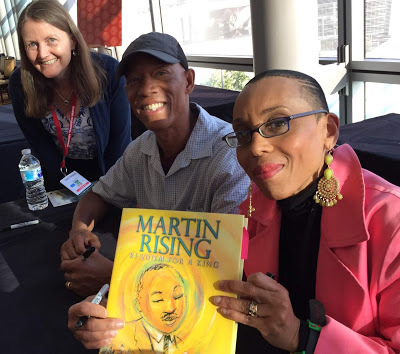 Fortunate to assist in this autograph session--with Brian Pinkney and Andrea Davis Pinkney
Fortunate to assist in this autograph session--with Brian Pinkney and Andrea Davis Pinkney
 Nonfiction Social with Alexis O'Neill, Pamela Turner, Melissa Stewart, Deborah Heiligman
Nonfiction Social with Alexis O'Neill, Pamela Turner, Melissa Stewart, Deborah Heiligman
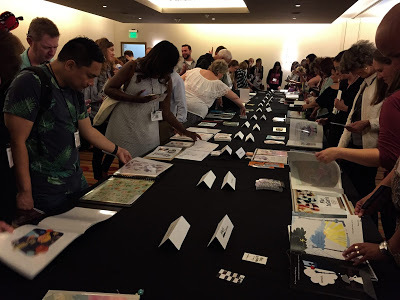 Illustrator Portfolio Showcase--just one of many rows of portfolios
Illustrator Portfolio Showcase--just one of many rows of portfolios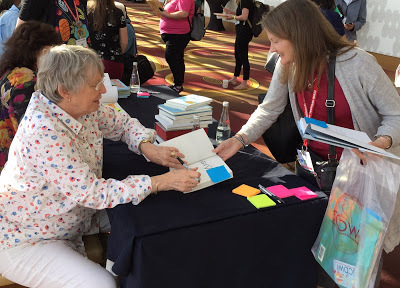 Lois Lowry signing a copy of THE GIVER for my Yokohama City University Students
Lois Lowry signing a copy of THE GIVER for my Yokohama City University Students International and Translation SocialSCBWI is such a supportive global community for writers, illustrators, translators, agents and editors to connect and learn from each other. I'm always inspired after being immerses in this community that creates for children and teens and believes deeply in the power of children's literature.
International and Translation SocialSCBWI is such a supportive global community for writers, illustrators, translators, agents and editors to connect and learn from each other. I'm always inspired after being immerses in this community that creates for children and teens and believes deeply in the power of children's literature.
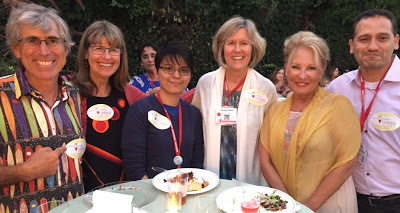 Authors Bruce Balan and April Halprin Wayland, SCBWI's Malena Fuentes Alzu, Nutschell Windsor, and Beverly Plass; Agent Deborah Warren, SCBWI's Ernesto Cisneros
Authors Bruce Balan and April Halprin Wayland, SCBWI's Malena Fuentes Alzu, Nutschell Windsor, and Beverly Plass; Agent Deborah Warren, SCBWI's Ernesto Cisneros
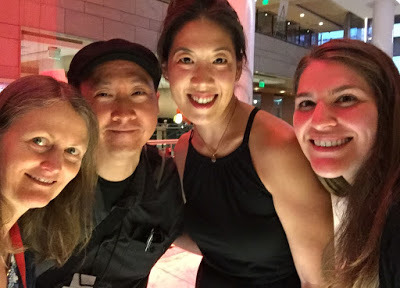 With illustrator Ken W. Min, author Cynthea Liu and Andrea Brown Literary Agency assistant Kayla CichelloThank you for a great conference @SCBWI !
With illustrator Ken W. Min, author Cynthea Liu and Andrea Brown Literary Agency assistant Kayla CichelloThank you for a great conference @SCBWI !
And what a conference, with nearly 1,200 attending from 18 countries and 48 US states! For the full run-down of the conference, including highlights of sessions and keynotes, see the many posts on the SCBWI Conference Blog.
Below are a few quotes from the many pages of notes I scribbled throughout the conference, plus a few pics.
Andrea Davis Pinkney, author, editor: "Everyone--write your own Dear Diversity letter and write what your own commitments to diversity will be."
 Fortunate to assist in this autograph session--with Brian Pinkney and Andrea Davis Pinkney
Fortunate to assist in this autograph session--with Brian Pinkney and Andrea Davis PinkneyDaniel José Older, author: "Stories are what will save us; votes are not enough. You are changing the world no matter what stories you write."
Elana K. Arnold, author: "If we don't let kids feel unsafe in a book, how will they know how to deal with feeling unsafe in the real world?"
Linda Mullaly Hunt, author: "Kids need us to reach out to the with our hearts. They need us to care more about them than our careers and ourselves. . . . Somewhere there is a child out there waiting for your book."
Ibi Zoboi, author: "Storytellers have a knack for telling other people's stories--we are telling the stories of people who are around us and those who aren't. It takes deep self-reflection about what we are seeing in the world--every day. The questions must be ongoing."
Deborah Heiligman, nonfiction author: "Take "Oh, wow!" notes when researching. Then hide those notes when writing your first draft," and "When you write fiction, you are a sculptor starting with clay. When you write nonfiction, it's like you're cutting marble to find the sculpture."
 Nonfiction Social with Alexis O'Neill, Pamela Turner, Melissa Stewart, Deborah Heiligman
Nonfiction Social with Alexis O'Neill, Pamela Turner, Melissa Stewart, Deborah HeiligmanLibba Bray, author: "Good books are humanity manuals."
Alexandra Penfold, agent, author: "A picture book is like a rubix cube."
Mike Curato, author/illustrator: "Be a friend to yourself--have fun."
 Illustrator Portfolio Showcase--just one of many rows of portfolios
Illustrator Portfolio Showcase--just one of many rows of portfoliosTina Dubois, agent: "Going through my inbox is like browsing in a bookshop--what do I want to read today?"
Kevin Lewis, author/agent: "Don't isolate yourself--you'll get vision from being out in the community finding things in the world that you want to change. Expand your field of vision."
Lois Lowry, author: Re. writing for children: "I don't think there is anything that shouldn't be written about --the darkness exists all around." And re. fiction writing: "Boldly go forth into the unknown. Then boldly go back to rework."
 Lois Lowry signing a copy of THE GIVER for my Yokohama City University Students
Lois Lowry signing a copy of THE GIVER for my Yokohama City University StudentsLaura Godwin, editor: "Bad things can happen in publishing. But you can handle them!"
 International and Translation SocialSCBWI is such a supportive global community for writers, illustrators, translators, agents and editors to connect and learn from each other. I'm always inspired after being immerses in this community that creates for children and teens and believes deeply in the power of children's literature.
International and Translation SocialSCBWI is such a supportive global community for writers, illustrators, translators, agents and editors to connect and learn from each other. I'm always inspired after being immerses in this community that creates for children and teens and believes deeply in the power of children's literature. Authors Bruce Balan and April Halprin Wayland, SCBWI's Malena Fuentes Alzu, Nutschell Windsor, and Beverly Plass; Agent Deborah Warren, SCBWI's Ernesto Cisneros
Authors Bruce Balan and April Halprin Wayland, SCBWI's Malena Fuentes Alzu, Nutschell Windsor, and Beverly Plass; Agent Deborah Warren, SCBWI's Ernesto Cisneros With illustrator Ken W. Min, author Cynthea Liu and Andrea Brown Literary Agency assistant Kayla CichelloThank you for a great conference @SCBWI !
With illustrator Ken W. Min, author Cynthea Liu and Andrea Brown Literary Agency assistant Kayla CichelloThank you for a great conference @SCBWI !
Published on August 20, 2018 14:18
March 18, 2018
Twilight Chant Book Trailer!
The Twilight Chant book launch is just a few days away.
And here's the new book trailer created by illustrator Jen Betton
For a look behind the scenes at the work that goes into creating a single picture book, check out all of the Twilight Chant process posts.
Read the writing process posts by Holly
Writing a Picture Book 1: A Twilight IdeaWriting a Picture Book 2: RevisionsWriting a Picture Book 3: Submission to OfferWriting a Picture Book 4: Contract to Illustrator to Launch
And read the illustration process posts by JenPart 1: Getting Started
Part 2: Thumbnails and Drawings
Part 3: Color Palette
Part 4: Color Script
Part 5: Patching Mistakes
Part 6: Final Paintings
And come celebrate with us at the launch at Porter Square Books in Cambridge, MA, on Friday, March 23, at 7:00 pm.
And here's the new book trailer created by illustrator Jen Betton
For a look behind the scenes at the work that goes into creating a single picture book, check out all of the Twilight Chant process posts.
Read the writing process posts by Holly
Writing a Picture Book 1: A Twilight IdeaWriting a Picture Book 2: RevisionsWriting a Picture Book 3: Submission to OfferWriting a Picture Book 4: Contract to Illustrator to Launch
And read the illustration process posts by JenPart 1: Getting Started
Part 2: Thumbnails and Drawings
Part 3: Color Palette
Part 4: Color Script
Part 5: Patching Mistakes
Part 6: Final Paintings
And come celebrate with us at the launch at Porter Square Books in Cambridge, MA, on Friday, March 23, at 7:00 pm.
Published on March 18, 2018 04:24
March 12, 2018
Hong Kong International Young Readers Festival
A few days ago I returned from a busy week in Hong Kong for the Hong Kong International Young Readers Festival where I was honored to be a featured author.

 My Hong Kong week was rich with school visits, at international schools as well as local schools, with presentations to students ranging from ages 5 to 17. Poetry, verse novels, prompts galore and rabbit hopping.
My Hong Kong week was rich with school visits, at international schools as well as local schools, with presentations to students ranging from ages 5 to 17. Poetry, verse novels, prompts galore and rabbit hopping.


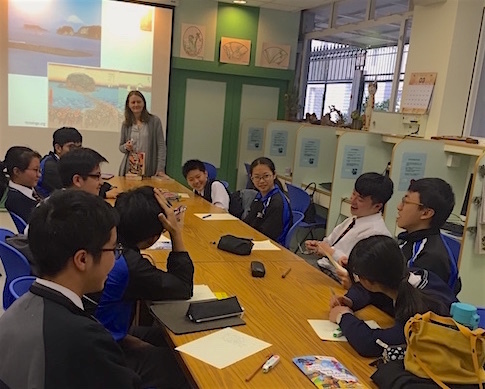

My radio interview with the wonderful Noreen Mir of RTHK is here.

You can listen to ALL of the Young Readers Festival 2018 radio interviews here.
In the evenings there was a chance to talk craft with SCBWI Hong Kong writers . . .

catch up with the other authors featured in the festival . . .

attend a fabulous talk and sloth drawing session with author/illustrator Gus Gordon . . .

join a lovely Women in Publishing Society dinner at the historic FCC Hong Kong, enjoy tea and dim sum at the lovely Lock Cha Tea House in Hong Kong Park, try some neon Yum Cha dim sum . . .

and sip a drink at the rooftop bar outside the China Club with Jenny Orchards, who makes the arts and everything literary happen wherever she is living.
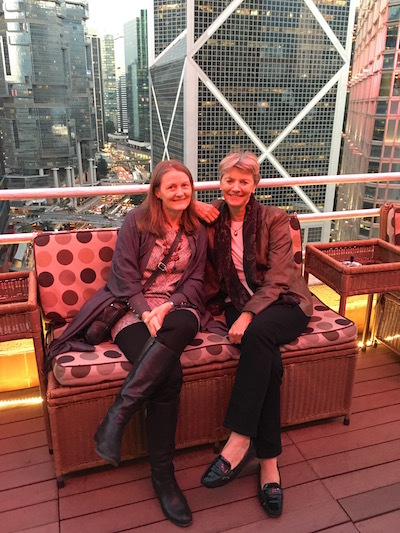
The weather cleared while I was there--blue skies . . .

and lovely temps for a quick walk through the botanical gardens and Hong Kong Park on my last morning.

Thank you to everyone at the Hong Kong International Young Readers Festival for inviting me and arranging all of the school visits and events. What an inspiring week! I look forward to returning!

 My Hong Kong week was rich with school visits, at international schools as well as local schools, with presentations to students ranging from ages 5 to 17. Poetry, verse novels, prompts galore and rabbit hopping.
My Hong Kong week was rich with school visits, at international schools as well as local schools, with presentations to students ranging from ages 5 to 17. Poetry, verse novels, prompts galore and rabbit hopping.



My radio interview with the wonderful Noreen Mir of RTHK is here.

You can listen to ALL of the Young Readers Festival 2018 radio interviews here.
In the evenings there was a chance to talk craft with SCBWI Hong Kong writers . . .

catch up with the other authors featured in the festival . . .

attend a fabulous talk and sloth drawing session with author/illustrator Gus Gordon . . .

join a lovely Women in Publishing Society dinner at the historic FCC Hong Kong, enjoy tea and dim sum at the lovely Lock Cha Tea House in Hong Kong Park, try some neon Yum Cha dim sum . . .

and sip a drink at the rooftop bar outside the China Club with Jenny Orchards, who makes the arts and everything literary happen wherever she is living.

The weather cleared while I was there--blue skies . . .

and lovely temps for a quick walk through the botanical gardens and Hong Kong Park on my last morning.

Thank you to everyone at the Hong Kong International Young Readers Festival for inviting me and arranging all of the school visits and events. What an inspiring week! I look forward to returning!
Published on March 12, 2018 23:59
March 8, 2018
#KidLitWomen Celebrating #WomenInTranslation
#KidLitWomen Celebrating Women in Translation
A #KidLitWomen post by Holly Thompson
We're celebrating Women's History month with 31 days of posts focused on improving the climate for social and gender equality in the children’s and teens’ literature community. Join in the conversation on Facebook https://www.facebook.com/kidlitwomen or Twitter #kidlitwomen

Having lived most of my adult life in Japan, and as an author and avid reader of children’s and YA literature, I’m always on the lookout for good books in translation, especially books translated from the languages of East and Southeast Asia. Sadly, few children’s books from Asian languages are translated into English. And in fact, few children’s books in translation are published in English in any given year. The result is that English-language books available to children are far from globally diverse.
Women in publishing have the power to change this dynamic, and this post aims to celebrate women in translation and urge more agents, editors and publishers to read translations, welcome translation submissions, and commit to making #worldkidlit part of their lists.
I’ve served as a regional advisor for SCBWI Japan for a number of years, and for ten years now we have had an active translation group. We hold Translation Day, a biennial conference, thanks to our Translator Coordinator Avery Fischer Udagawa. Our aim is to cultivate and encourage Japanese to English translators, and to raise awareness of Japanese children’s books worthy of translation. We also uphold the 3 Cs for Translators (copyright to their translations, compensation, and credit).
Yet even well-informed translators face formidable barriers, because getting English-language publishers interested in translations is difficult. In North America, few publishers are willing to take the risk of publishing titles that do not fit the norm of what they typically publish and deem marketable—especially in the case of middle grade and young adult books. Editors often seem stymied or put off by “foreign” modes of storytelling, authorial worldviews, and settings. Yet in a global age, these elements are precisely why we should be paying attention to translations—reading, sharing and shouting out about children’s books in translation—so that young readers of English can meet their diverse and complex world.
Kudos to those editors and publishers who publish translations of children’s literature, including Pushkin Children’s, Groundwood Books, Eerdmans Books for Young Readers,Arthur A. Levine Books, Enchanted Lion Press, the new Elsewhere Editions, and the new Restless Books.
Applause for the work of IBBY, whose biennial Hans Christian Andersen Award (“little Nobel”) brings world authors and illustrators for children into the international spotlight. See the Andersen Award nominees for 2018 here.
Here’s a must-read post about translator, publisher and IBBY president Patricia Aldana: Meet the Publisher—Groundwood Books’ Patricia Aldana on Children’s Literature in Translation
Here’s a cover story in the April 2017 School Library Journal about the need for translations: Outlandish: Braving New Perspectives through Books in Translation
Here's a post in The Horn Book by Elena Abôs: Foreign Correspondence: Translator: Trafficking Between Cultures.
Here’s a classic essay in The Horn Book about the craft of translating children’s literature, one of the least understood creative jobs in our industry: Eight Ways to Say You: The Challenges of Translation
And now, let’s hear from #KidLitWomen celebrating #WomenInTranslation in children’s literature.
Anamaria Anderson, writer and translator from her native Spanish, and museum educator at the National Gallery of Art, writes:
“I was on the 2014 Batchelder Award committee along with four other women (Doris Gebel, Linda Pavonetti, Marion Rocco and our chair Maureen White). I learned so much from my fellow committee members, some of whom have been active in the field of international and translated children's literature for many years. The award itself, of course, is named for a woman: Mildred L. Batchelder. We recognized the publishers of one winner and three honor books in 2014, all of which were translated into English by women—something I hadn't noticed at the time! Laura Watkinson, who translates from Dutch, German, and Italian into English, translated two of our books (both from the Dutch), including the winner, Mister Orange by Truus Matti (Enchanted Lion). Kari Dickson (Norwegian) and Claudia Zoe Bedrick (French) translated the others. All three are good names to know. Because the Batchelder is awarded to the publisher, I'd also like to call attention to the women publishers of the books on our list. Claudia Bedrick does double duty at Enchanted Lion, and Anita Eerdmans of Eerdmans Books for Young Readers also consistently publishes award-winning international and translated children's books.
“Unfortunately, there don't seem to be as many Spanish to English translations published as there are translations from, for example, the French. I would love to see this number grow--I feel strongly that diverse books and translated books are two sides of the same coin, and that we should mint more of them. Please be in touch if you're interested in making this happen!”
Shelley Tanaka is fiction editor at Groundwood Books and also works as a children’s book translator (from French and German into English) for Groundwood and other publishers. She writes:
“Groundwood publishes a large number of books in translation. Most of our translators and creators are women, but not all. A few recent and upcoming titles:· On the Other Side of the Garden (Al otro lado del jardin) by Jairo Buitrago and Rafael Yockteng, translated from Spanish by Elisa Amado (2018)· Your Turn, Adrian (Din tur, Adrian), by Helena Oberg and Kristin Lidström, translated from Swedish by Eva Apelqvist (2018)· Ophelia (Ophélie) by Charlotte Gingras (illustrated by Daniel Sylvestre), translated from French by Christelle Morelli and Susan Ouriou (2018)· Grandfather and the Moon (Grand-père et la lune) by Stéphanie Lapointe and Rogé, translated from French by Shelley Tanaka (2017)· Louis Undercover (Louis parmi les spectres) by Fanny Britt and Isabelle Arsenault, translated from French by Christelle Morelli and Susan Ouriou (2017)· Nipêhon / I Wait by Caitlin Dale Nicholson, translated from Cree by Leona Morin-Neilson (2017)· Kisimi Taimaippaktut Angirrarijarani / Only in My Hometown by Angnakuluk Friesen and Ippiksaut Friesen, translated from English into Inuktitut by Jean Kusugak (2017)· And So It Goes (Es así) by Paloma Valdivia, translated from Spanish by Susan Ouriou (2017)· Along the River (Pelo rio) by Vanina Starkoff, translated from Portuguese by Jane Springer (2017)
Sarah Odedina, Editor at Large at Pushkin Press, writes:
“I would like to mention Sarah Ardizzone (interview) who is an outstanding translator from French to English and also something of an activist when it comes to translating urban/street French in to its equivalent English. She is engaged and passionate and is a wonderful advocate for sharing people's stories from all walks of life—not just the high literary end. Sarah has won the Marsh Prize for Children's Literature in Translation twice – first in 2005 for Daniel Pennac's Eye of the Wolf and again in 2009 for Timothée de Fombelle's Toby Alone – and was awarded the Scott-Moncrieff Prize in 2007 for her work on Faïza Guène’s Just Like Tomorrow. Most recently, she received praise for her work on Joann Sfar's graphic novel version of The Little Prince. Sarah has published some 40 titles by writers such as Daniel Pennac, Yasmina Reza and Alexandre Dumas. She specializes in translating sharp dialogue, urban and migrant slang—which she calls ‘a world literature in French.’ Sarah also curates educational programmes—including Translation Nation, Translators in Schoolsand the Spectacular Translation Machine—and is a patron of children’s world literature charity Outside In World.
“Then there is the wonderful Anthea Bell (interview) whose work spans decades and who translates from German, Danish and French, making her quite outstanding. Her work spans genres, too, and includes the wonderful Asterix comics as well as Austerlitz by W. G. Sebald and books by Cornelia Funke. Anthea raised the bar on translating books for young readers in to English and brought to generations of young readers excellent fiction from around the world.
“I profoundly believe that stories share in their DNA the ability to entertain and amuse and educate and inform. The notion that foreign fiction is less relevant than home grown fiction is no longer possible to sustain as the world becomes more and more enriched by ideas in to groups from areas outside their immediate sphere of understanding. A book I am incredibly proud of publishing is the Head of The Saint by Socorro Acioli, an author from the North-East of Brazil. When I first met Socorro, she mentioned two or three book ideas to me which felt familiar, and I said to her that I wanted to hear about the book 'that only you can write.' She told me of the idea for The Head of The Saint. It is a story about a boy in the interior of Brazil, about magic and saints and love and a curse on a family. I published the book to great acclaim, we sold rights around the world including to the USA where the book won a prestigious award. While the setting of the book may be unfamiliar, the quest and love and resolution of the story is something that all readers can identitify with—whether they are in Bradford, Baltimore, Berlin or Brasilia.”
Avery Fischer Udagawa is Translator Coordinator for SCBWI and for SCBWI Japan (and hosts the SCBWI Japan Translation Group Blog). When asked for some of her favorite women translating #kidlitwomen said, “Wow, there are so many great ones! Marian Schwartz translated Daria Wilke’s Playing a Part, a Russian coming-of-age and coming-out YA novel, released after the Kremlin passed laws prohibiting ‘gay propaganda.’ The late Dorothy Britton translated The Girl with the White Flag by Tomiko Higa, wrenching YA nonfiction about surviving the Battle of Okinawa as a seven-year-old child. Nancy Roberts translated Code Name Butterfly by Ahlam Bsharat, a Palestinian writer who portrays a teen girl's life under occupation with both humor and poignancy. My understanding of world conflicts and resilience has been immeasurably enriched by women translating women for young readers. Here's to the intersection of #womenintranslation and #worldkidlit!”
Rosie Hedger translates from Norwegian into English, and is passionate about increasing the range of Norwegian authors translated into English, with a particular focus on the work of contemporary female authors. Asked about translating the novel Almost Autumn by Marianne Kaurin, Rosie shares: “Almost Autumn was a really interesting title to make into English as it's hard for translated novels to break into the English market, and when they do they also tend to break into several other language markets. This one hadn't at the time it was picked up by its US publisher, but it was suggested to me by one agent that European countries each have their own WWII stories that remain fairly fresh in the national consciousness, whilst a US audience wouldn't necessarily be aware of the impact of the Holocaust on a smaller nation such as Norway, making this a title of interest for those readers. I think Kaurin's novel highlights the real-life impact of this episode in history, and her approach is relatable, harrowing and, fundamentally, very well researched.”
Sally Ito, who co-translatedwith her aunt Michiko Tsuboi poems of Misuzu Kaneko for the picture book Are You An Echo: The Lost Poetry of Misuzu Kaneko (Chin Music Press), said in an interview with Tofugu that Misuzu’s poems show us a fresh sensibility and specifically “how to be compassionate, empathetic and notice the lives of other creatures, and things, too!” Sally shares:
“Michiko and I continue our translating work on Misuzu Kaneko’s poetry; we are hoping to eventually translate all of the 512 poems Misuzu wrote in her lifetime that are published in a six-volume set, edited by Setsuo Yazaki, the man who recovered Misuzu’s work from obscurity in Japan. As I am a poet, I find translating poetry to be a wonderful exercise for expanding one’s vocabulary in one’s own language, as well as finding expressions for things that are unique to certain languages and cultures. One of the interesting things I’ve discovered in my translation work—(I look for and have translated women poets from other languages than Japanese)—is how some woman poets of other languages have written for children. More often than not, these works are unavailable in English. Take for example, Polish poet Anna Swir and Luxembourgish poet, Anise Koltz. I feel there is new frontier of translation work to be explored here and it is my hope that a new multilingual generation of global citizens will take on that work for the future!”
Award-winning opera singer Nanette McGuinness is the translator of nearly 50 graphic novels and books for children and adults, including Penelope Bagieu's California Dreamin’: Cass Elliott Before The Mamas & the Papas (2018 YALSA Great Graphic Novels for Teens) and Luisa: Now and Then (upcoming June 2018, by Carole Maurel), both graphic novels that deal with identity and self-image. She cares deeply about the contributions of women in all the arts (her first CD, "Fabulous Femmes," was of music by women composers). When asked about #WomenInTranslation to spotlight, Nanette said:
"There are so many! A few who spring to mind are: Katherine Woods, who translated The Little Prince; Anthea Bell, who has translated many authors, including Kai Meyer, Cornelia Funke, Antonia Michaelis, and Goscogny/ Uderzo (Asterix); Laura Watkinson, who won the Batchelder Award for her translation of Mikis and the Donkey by Bibi Dumon Tak; and Helen Wang, who recently won the Marsh Award for her translation of Cao Wenxuan's Bronze and Sunflower."
And in this interview on SCBWI: The Blog, Nanette recommends classic children’s translations by and of women, from Heidi to Pippi Longstocking.
Helen Wang (interviewedby Daniel Hahn) translates from Chinese into English and hosts the excellent blog Chinese Books for Young Readers. See Helen’s recent interview with translator Chloe Garcia Roberts and many other insightful posts. Here also is a review of Helen Wang’s translation of Bronze and Sunflower by Cao Wenxuan (China’s first-ever Andersen laureate), for which she recently received the UK’s Marsh Award for Children’s Literature in Translation. For this #KidLitWomen post, Helen wishes to shine the spotlight on a novel she translated, A Ventriloquist’s Daughter by Man-Chiu LIN (Balestier Press, 2017)—“about a young girl whose father goes AWOL in the USA and South America for five years. When he finally returns home, father and daughter cannot reconcile. He can only speak to her through his ventriloquist’s doll; she cannot stand the doll. The more she projects her own feelings on to the doll, the more difficult it becomes for her to distinguish between reality and fantasy.”
Lyn Miller-Lachman translates from Portuguese into English, and she writes:
“I’d like to feature Portuguese writers of children’s books from two generations. Isabel Minhós Martins is the co-founder of the award-winning publishing house Planeta Tangerina, located outside Lisbon, and an author of more than a dozen picture books. I translated The World in a Second (Enchanted Lion, 2015), illustrated by Bernardo L. Carvalho. It’s a humorous, colorful, and multi-layered depiction of events happening in the same second in 23 locations throughout the world. Isabel’s career as a teller of stories began, however, in summer camp, where Henriqueta Cristina, her camp counselor, regaled her with tales of life in Portugal before Isabel was born, at a time when the country was ruled by a dictator and Henriqueta’s neighbors and friends had to flee for their lives to places unknown. I had the privilege of translating Henriqueta’s debut picture book, published by Planeta Tangerina and illustrated by the Brazilian-born artist Yara Kono. Three Balls of Wool (Can Change the World) (Enchanted Lion, 2017) follows a family from fascist Portugal to communist Czechoslovakia, where “all children go to school,” but otherwise there’s no more freedom than in the country that they left. However, this undaunted refugee family sets about making change in their corner of the world, showing the ways that immigrants and refugees enrich their adopted lands.”
See also Lyn’s post “The Time Has Come for Three Balls of Wool (Can Change the World)” here. See also “Lyn Miller-Lachmann on Literature in Translation as Empowering Own Voices” on the Cynsations blog here.
Laura Watkinson (interviewon Playing by the Book), a translator from Dutch of multiple Batchelder Award winners, discusses her translation of Heartsingerby Karlijn Stoffels (among others!) as well as ways translators can promote themselves and their work, on the SCBWI Japan Translation Group blog. Laura shares:
“A woman I’d really like to celebrate is Tonke Dragt. One of the questions I used to hear most often as a translator from Dutch was: “Why hasn’t Tonke Dragt been translated into English yet?” Followed by: “And what are you going to do about it?” They were both very fair questions. Tonke Dragt is a fantastically imaginative children’s author (and illustrator), whose body of work encompasses a range of genres. She is perhaps best known for The Letter for the King, a tale about a young would-be knight and his perilous mission. First published in Dutch in 1962, it’s still hugely popular today and I find it quite baffling that it wasn’t translated into English back in the 1960s, partly because it feels like such a natural fit with the canon of children’s literature written in English. The brilliant publisher Adam Freudenheim, from Pushkin Press, finally brought this book into English in 2013, in a beautiful edition that did justice to the book and its author. I felt so lucky to have the opportunity to translate the book, along with its sequel, The Secrets of the Wild Wood,and another title by Tonke Dragt, The Song of Seven, which was also huge fun to translate and full of little puns and riddles. And I’m so glad that Tonke Dragt got to see her books translated into English, as I know this was something she wanted. If only it could have happened years ago! I’m now working on a new book for Pushkin Press, Lampje by Annet Schaap, another wonderful Dutch author/illustrator, which was published in Dutch to great acclaim only last year. Thank goodness this great author didn’t have to wait over half a century to see her book make it into English. Things are looking up in the world of translation!”
Ginny Tapley Takemori, translator of two works for children published by Pushkin Children’s, shares: “One work for young adults that is close to my heart is Akiyuki Nosaka’s The Whale that Fell in Love with a Submarine . This collection of tales of war, seen through the eyes of children (the author experienced the war as a child), are heartbreaking yet full of humanity and love in the midst of tragedy.”
Editor Sayoni Basu, of Duckbill Books in New Delhi, India, writes:
“Some of the translations of books for children and young adults by women writers translated into English by women translators include the best-known names from some Indian languages. These include the following:
· The hilarious Bengali writer Lila Mazumdar whose wonderful The Burmese Box and Other Stories has been translated by Srilata Banerjee; The Yellow Bird has been translated by Kamala Chatterjee; and Tong Ling Express has been translated by Nivedita Sen; Sahitya Akademi. · Well-known Marathi writer Madhuri Purandare has had several books translated into English: The Hundred and Thirty-seventh Leg translated into English by Sai Keskar, Radha's Family translated by Rama Hardikar and On That Day (for teens) translated by Rama Hardikar. Silver Star was translated by Rama Hardeekar-Sakhadeo.· Also from Marathi, is Wings by Asha Bage; translated by Gauri Deshpande. · From Tamil, some of the books which have been translated into English are Dear Earth by Avaiyyar, translated by Geeta Dharmarajan; Dobakatti, written and translated by Geeta Dharmarajan; I am Aan by Meenakshi Bharadwaj, translated by Geeta Dharmarajan. · From Hindi, some of the kids' books translated into English are Bioscope written and translated by Mamta Nainy; Malu Bhalu by Kamla Bhasin, translated by Sandhya Rao (Kamla Bhasin is a well-known women's rights activist).· From Kannada, The Neverending Story written and translated by Ashwini Bhat
Sayoni notes: “While this list is scant, there much translation that happens in India is between different Indian languages. We have six so-called classical languages and twenty-two officially recognised languages--so that is a flourishing form of translation as well. There tends to be a lot of translation from English to other Indian languages as well.” Publishers that specialize in translations among Indian languages include Tulika Books, Katha Books and Pratham Books.
Author Suzanne Kamata shares her enthusiasm for Piglettes (Pushkin Press, 2017): “initially written in French by Clementine Beauvais (and recently translated into English by the author), is an award-winning young adult novel about three girls who become friends after being voted "Pig Pageant winners," i.e. the ugliest in their school, on Facebook. The book deals with contemporary issues such as cyber-bullying and body-shaming, yet manages to be light, entertaining, and ultimately, empowering.”
Smithsonian BookDragon, which is “inhabited” by Terry Hong features reviews of Asia Pacific titles and diverse global titles for children and adults, many in translation. Some prior translation reviews include books in the I See the Sun Series , such as Burma , India , and Mexico ; Melissa Tanaka’s translation from Japanese of Dissolving Classroom ; and Mariko Shii Gharbi’s translations from Japanese of the Tyrannosaurus series (Museyon). Mariko Shii Gharbi also translated Gon, The Little Fox by Nankichi Niimi (Museyon). Terry says, “I DOOOOO love Museyon. They do adorable books for younger readers. And the Tyrannosaurus series deserves so much more attention Stateside.” When asked about recent YA titles, Terry writes:
“Anne Ishii, who used to work at Vertical, Inc. does amazing translations ... her latest is one of my favorite manga: My Brother’s Husband (Volume 1) by Gengoroh Tagume. I also loved Not Simple, by Natsume Ono, translated by Joe Yamazaki, English adaptation by Anne Ishii. I’d say both of the above titles are okay for YA audiences. And Vertical, bought by Kodansha some years back, has managed to stay pretty independent and brings intriguing, edgy, non-canonical Japanese titles to Anglophone readers. And I LOVED this MG/YA manga: The Gods Lie, by Kaori Ozaki, translated by Melissa Tanaka. And, of course, the adorable Fuku Fuku manga series: Fuku Fuku Kitten Tales, by Konami Kanata, translated by Marlaina McElheny and Ed Chavez.
Zoe Toft of the wonderful blog Playing by the Book has been shining a spotlight on children’s books in translation: Charlie’s Magic Carnival , A Brazilian Classic Plus a Translator Spotlight , Žanete Vēvere Pasqualini , Impossible Inventions , and Are You an Echo? . Follow Playing by the Book for future spotlight posts.
Marcia Lynx Qualey co-created the September observance of #WorldKidLit Month and recommends books at WorldKidLit Month and the ArabLit blog.
Rachel Hildebrandt spearheads the Global Literature in Libraries Initiative, with a blog that includes posts on children’s/YA world kidlit involving women, including The Last Execution by Jesper Wung-Sung, translated by Lindy Falk van Rooyen; Departure Time by Truus Matti, translated by Nancy Forest-Flier; and Deep Sea by Annika Thor, translated by Linda Schenk.
And a few of my own favorite translations by/of #kidlitwomen for middle grade and YA:
· Cathy Hirano has translated the nuanced realistic literary works of Kazumi Yumoto—The Friends, The Spring Tone and The Letters—as well as fantasy works from Nahoko Uehashi’s Moribito series, editedby Cheryl Klein, and the forthcoming The Beast Player by Uehashi: here’s a reviewof this new fantasy translation to help you dive in. · Ginny Tapley Takemori translated Tomiko Inui’s The Secret of the Blue Glass (reviewed on Readings in Translated Japanese Literature), a story that blends historical fiction with fantasy and centers on a child evacuee in wartime Japan caring for a little family—published by Pushkin Press, which has been actively publishing children’s world literature. · Requiem by Shizuko Go and translated by Geraldine Harcourt, paints a searing and lyrical portrait of a teen struggling to survive after the May 1945 firebombing of Yokohama. · And I love the ALSC Batchelder Award-winning book by Anne-Laure Bondoux, A Time of Miracles , translated from French by Y. Maudet, about a refugee boy and his mother fleeing the Caucasus.
Finally, two women translators above created the below 2 lists of 100 books to kickstart anyone’s global children’s literature collection. Ready to rock (or read) a kid’s world? Begin here! Order from your favorite library or bookstore.
100 Great Translated Children’s Books from Around the World100 More Translated Children’s Books from Around the World
May this #KidLitWomen post bring more attention to the world’s #KidLitWomen, and may more women in publishing in English-speaking countries find creative and effective means for supporting and publishing more translations into English of #WorldKidLit.
There are many more #KidLitWomen titles from #WomenInTranslation to shout out about. Celebrate your favorite children's and YA titles by sharing in the comments section below.
We're celebrating Women's History month with 31 days of posts focused on improving the climate for social and gender equality in the children’s and teens’ literature community. Join in the conversation on Facebook https://www.facebook.com/kidlitwomen or Twitter #kidlitwomen!

A #KidLitWomen post by Holly Thompson
We're celebrating Women's History month with 31 days of posts focused on improving the climate for social and gender equality in the children’s and teens’ literature community. Join in the conversation on Facebook https://www.facebook.com/kidlitwomen or Twitter #kidlitwomen

Having lived most of my adult life in Japan, and as an author and avid reader of children’s and YA literature, I’m always on the lookout for good books in translation, especially books translated from the languages of East and Southeast Asia. Sadly, few children’s books from Asian languages are translated into English. And in fact, few children’s books in translation are published in English in any given year. The result is that English-language books available to children are far from globally diverse.
Women in publishing have the power to change this dynamic, and this post aims to celebrate women in translation and urge more agents, editors and publishers to read translations, welcome translation submissions, and commit to making #worldkidlit part of their lists.
I’ve served as a regional advisor for SCBWI Japan for a number of years, and for ten years now we have had an active translation group. We hold Translation Day, a biennial conference, thanks to our Translator Coordinator Avery Fischer Udagawa. Our aim is to cultivate and encourage Japanese to English translators, and to raise awareness of Japanese children’s books worthy of translation. We also uphold the 3 Cs for Translators (copyright to their translations, compensation, and credit).
Yet even well-informed translators face formidable barriers, because getting English-language publishers interested in translations is difficult. In North America, few publishers are willing to take the risk of publishing titles that do not fit the norm of what they typically publish and deem marketable—especially in the case of middle grade and young adult books. Editors often seem stymied or put off by “foreign” modes of storytelling, authorial worldviews, and settings. Yet in a global age, these elements are precisely why we should be paying attention to translations—reading, sharing and shouting out about children’s books in translation—so that young readers of English can meet their diverse and complex world.
Kudos to those editors and publishers who publish translations of children’s literature, including Pushkin Children’s, Groundwood Books, Eerdmans Books for Young Readers,Arthur A. Levine Books, Enchanted Lion Press, the new Elsewhere Editions, and the new Restless Books.
Applause for the work of IBBY, whose biennial Hans Christian Andersen Award (“little Nobel”) brings world authors and illustrators for children into the international spotlight. See the Andersen Award nominees for 2018 here.
Here’s a must-read post about translator, publisher and IBBY president Patricia Aldana: Meet the Publisher—Groundwood Books’ Patricia Aldana on Children’s Literature in Translation
Here’s a cover story in the April 2017 School Library Journal about the need for translations: Outlandish: Braving New Perspectives through Books in Translation
Here's a post in The Horn Book by Elena Abôs: Foreign Correspondence: Translator: Trafficking Between Cultures.
Here’s a classic essay in The Horn Book about the craft of translating children’s literature, one of the least understood creative jobs in our industry: Eight Ways to Say You: The Challenges of Translation
And now, let’s hear from #KidLitWomen celebrating #WomenInTranslation in children’s literature.
Anamaria Anderson, writer and translator from her native Spanish, and museum educator at the National Gallery of Art, writes:
“I was on the 2014 Batchelder Award committee along with four other women (Doris Gebel, Linda Pavonetti, Marion Rocco and our chair Maureen White). I learned so much from my fellow committee members, some of whom have been active in the field of international and translated children's literature for many years. The award itself, of course, is named for a woman: Mildred L. Batchelder. We recognized the publishers of one winner and three honor books in 2014, all of which were translated into English by women—something I hadn't noticed at the time! Laura Watkinson, who translates from Dutch, German, and Italian into English, translated two of our books (both from the Dutch), including the winner, Mister Orange by Truus Matti (Enchanted Lion). Kari Dickson (Norwegian) and Claudia Zoe Bedrick (French) translated the others. All three are good names to know. Because the Batchelder is awarded to the publisher, I'd also like to call attention to the women publishers of the books on our list. Claudia Bedrick does double duty at Enchanted Lion, and Anita Eerdmans of Eerdmans Books for Young Readers also consistently publishes award-winning international and translated children's books.
“Unfortunately, there don't seem to be as many Spanish to English translations published as there are translations from, for example, the French. I would love to see this number grow--I feel strongly that diverse books and translated books are two sides of the same coin, and that we should mint more of them. Please be in touch if you're interested in making this happen!”
Shelley Tanaka is fiction editor at Groundwood Books and also works as a children’s book translator (from French and German into English) for Groundwood and other publishers. She writes:
“Groundwood publishes a large number of books in translation. Most of our translators and creators are women, but not all. A few recent and upcoming titles:· On the Other Side of the Garden (Al otro lado del jardin) by Jairo Buitrago and Rafael Yockteng, translated from Spanish by Elisa Amado (2018)· Your Turn, Adrian (Din tur, Adrian), by Helena Oberg and Kristin Lidström, translated from Swedish by Eva Apelqvist (2018)· Ophelia (Ophélie) by Charlotte Gingras (illustrated by Daniel Sylvestre), translated from French by Christelle Morelli and Susan Ouriou (2018)· Grandfather and the Moon (Grand-père et la lune) by Stéphanie Lapointe and Rogé, translated from French by Shelley Tanaka (2017)· Louis Undercover (Louis parmi les spectres) by Fanny Britt and Isabelle Arsenault, translated from French by Christelle Morelli and Susan Ouriou (2017)· Nipêhon / I Wait by Caitlin Dale Nicholson, translated from Cree by Leona Morin-Neilson (2017)· Kisimi Taimaippaktut Angirrarijarani / Only in My Hometown by Angnakuluk Friesen and Ippiksaut Friesen, translated from English into Inuktitut by Jean Kusugak (2017)· And So It Goes (Es así) by Paloma Valdivia, translated from Spanish by Susan Ouriou (2017)· Along the River (Pelo rio) by Vanina Starkoff, translated from Portuguese by Jane Springer (2017)
Sarah Odedina, Editor at Large at Pushkin Press, writes:
“I would like to mention Sarah Ardizzone (interview) who is an outstanding translator from French to English and also something of an activist when it comes to translating urban/street French in to its equivalent English. She is engaged and passionate and is a wonderful advocate for sharing people's stories from all walks of life—not just the high literary end. Sarah has won the Marsh Prize for Children's Literature in Translation twice – first in 2005 for Daniel Pennac's Eye of the Wolf and again in 2009 for Timothée de Fombelle's Toby Alone – and was awarded the Scott-Moncrieff Prize in 2007 for her work on Faïza Guène’s Just Like Tomorrow. Most recently, she received praise for her work on Joann Sfar's graphic novel version of The Little Prince. Sarah has published some 40 titles by writers such as Daniel Pennac, Yasmina Reza and Alexandre Dumas. She specializes in translating sharp dialogue, urban and migrant slang—which she calls ‘a world literature in French.’ Sarah also curates educational programmes—including Translation Nation, Translators in Schoolsand the Spectacular Translation Machine—and is a patron of children’s world literature charity Outside In World.
“Then there is the wonderful Anthea Bell (interview) whose work spans decades and who translates from German, Danish and French, making her quite outstanding. Her work spans genres, too, and includes the wonderful Asterix comics as well as Austerlitz by W. G. Sebald and books by Cornelia Funke. Anthea raised the bar on translating books for young readers in to English and brought to generations of young readers excellent fiction from around the world.
“I profoundly believe that stories share in their DNA the ability to entertain and amuse and educate and inform. The notion that foreign fiction is less relevant than home grown fiction is no longer possible to sustain as the world becomes more and more enriched by ideas in to groups from areas outside their immediate sphere of understanding. A book I am incredibly proud of publishing is the Head of The Saint by Socorro Acioli, an author from the North-East of Brazil. When I first met Socorro, she mentioned two or three book ideas to me which felt familiar, and I said to her that I wanted to hear about the book 'that only you can write.' She told me of the idea for The Head of The Saint. It is a story about a boy in the interior of Brazil, about magic and saints and love and a curse on a family. I published the book to great acclaim, we sold rights around the world including to the USA where the book won a prestigious award. While the setting of the book may be unfamiliar, the quest and love and resolution of the story is something that all readers can identitify with—whether they are in Bradford, Baltimore, Berlin or Brasilia.”
Avery Fischer Udagawa is Translator Coordinator for SCBWI and for SCBWI Japan (and hosts the SCBWI Japan Translation Group Blog). When asked for some of her favorite women translating #kidlitwomen said, “Wow, there are so many great ones! Marian Schwartz translated Daria Wilke’s Playing a Part, a Russian coming-of-age and coming-out YA novel, released after the Kremlin passed laws prohibiting ‘gay propaganda.’ The late Dorothy Britton translated The Girl with the White Flag by Tomiko Higa, wrenching YA nonfiction about surviving the Battle of Okinawa as a seven-year-old child. Nancy Roberts translated Code Name Butterfly by Ahlam Bsharat, a Palestinian writer who portrays a teen girl's life under occupation with both humor and poignancy. My understanding of world conflicts and resilience has been immeasurably enriched by women translating women for young readers. Here's to the intersection of #womenintranslation and #worldkidlit!”
Rosie Hedger translates from Norwegian into English, and is passionate about increasing the range of Norwegian authors translated into English, with a particular focus on the work of contemporary female authors. Asked about translating the novel Almost Autumn by Marianne Kaurin, Rosie shares: “Almost Autumn was a really interesting title to make into English as it's hard for translated novels to break into the English market, and when they do they also tend to break into several other language markets. This one hadn't at the time it was picked up by its US publisher, but it was suggested to me by one agent that European countries each have their own WWII stories that remain fairly fresh in the national consciousness, whilst a US audience wouldn't necessarily be aware of the impact of the Holocaust on a smaller nation such as Norway, making this a title of interest for those readers. I think Kaurin's novel highlights the real-life impact of this episode in history, and her approach is relatable, harrowing and, fundamentally, very well researched.”
Sally Ito, who co-translatedwith her aunt Michiko Tsuboi poems of Misuzu Kaneko for the picture book Are You An Echo: The Lost Poetry of Misuzu Kaneko (Chin Music Press), said in an interview with Tofugu that Misuzu’s poems show us a fresh sensibility and specifically “how to be compassionate, empathetic and notice the lives of other creatures, and things, too!” Sally shares:
“Michiko and I continue our translating work on Misuzu Kaneko’s poetry; we are hoping to eventually translate all of the 512 poems Misuzu wrote in her lifetime that are published in a six-volume set, edited by Setsuo Yazaki, the man who recovered Misuzu’s work from obscurity in Japan. As I am a poet, I find translating poetry to be a wonderful exercise for expanding one’s vocabulary in one’s own language, as well as finding expressions for things that are unique to certain languages and cultures. One of the interesting things I’ve discovered in my translation work—(I look for and have translated women poets from other languages than Japanese)—is how some woman poets of other languages have written for children. More often than not, these works are unavailable in English. Take for example, Polish poet Anna Swir and Luxembourgish poet, Anise Koltz. I feel there is new frontier of translation work to be explored here and it is my hope that a new multilingual generation of global citizens will take on that work for the future!”
Award-winning opera singer Nanette McGuinness is the translator of nearly 50 graphic novels and books for children and adults, including Penelope Bagieu's California Dreamin’: Cass Elliott Before The Mamas & the Papas (2018 YALSA Great Graphic Novels for Teens) and Luisa: Now and Then (upcoming June 2018, by Carole Maurel), both graphic novels that deal with identity and self-image. She cares deeply about the contributions of women in all the arts (her first CD, "Fabulous Femmes," was of music by women composers). When asked about #WomenInTranslation to spotlight, Nanette said:
"There are so many! A few who spring to mind are: Katherine Woods, who translated The Little Prince; Anthea Bell, who has translated many authors, including Kai Meyer, Cornelia Funke, Antonia Michaelis, and Goscogny/ Uderzo (Asterix); Laura Watkinson, who won the Batchelder Award for her translation of Mikis and the Donkey by Bibi Dumon Tak; and Helen Wang, who recently won the Marsh Award for her translation of Cao Wenxuan's Bronze and Sunflower."
And in this interview on SCBWI: The Blog, Nanette recommends classic children’s translations by and of women, from Heidi to Pippi Longstocking.
Helen Wang (interviewedby Daniel Hahn) translates from Chinese into English and hosts the excellent blog Chinese Books for Young Readers. See Helen’s recent interview with translator Chloe Garcia Roberts and many other insightful posts. Here also is a review of Helen Wang’s translation of Bronze and Sunflower by Cao Wenxuan (China’s first-ever Andersen laureate), for which she recently received the UK’s Marsh Award for Children’s Literature in Translation. For this #KidLitWomen post, Helen wishes to shine the spotlight on a novel she translated, A Ventriloquist’s Daughter by Man-Chiu LIN (Balestier Press, 2017)—“about a young girl whose father goes AWOL in the USA and South America for five years. When he finally returns home, father and daughter cannot reconcile. He can only speak to her through his ventriloquist’s doll; she cannot stand the doll. The more she projects her own feelings on to the doll, the more difficult it becomes for her to distinguish between reality and fantasy.”
Lyn Miller-Lachman translates from Portuguese into English, and she writes:
“I’d like to feature Portuguese writers of children’s books from two generations. Isabel Minhós Martins is the co-founder of the award-winning publishing house Planeta Tangerina, located outside Lisbon, and an author of more than a dozen picture books. I translated The World in a Second (Enchanted Lion, 2015), illustrated by Bernardo L. Carvalho. It’s a humorous, colorful, and multi-layered depiction of events happening in the same second in 23 locations throughout the world. Isabel’s career as a teller of stories began, however, in summer camp, where Henriqueta Cristina, her camp counselor, regaled her with tales of life in Portugal before Isabel was born, at a time when the country was ruled by a dictator and Henriqueta’s neighbors and friends had to flee for their lives to places unknown. I had the privilege of translating Henriqueta’s debut picture book, published by Planeta Tangerina and illustrated by the Brazilian-born artist Yara Kono. Three Balls of Wool (Can Change the World) (Enchanted Lion, 2017) follows a family from fascist Portugal to communist Czechoslovakia, where “all children go to school,” but otherwise there’s no more freedom than in the country that they left. However, this undaunted refugee family sets about making change in their corner of the world, showing the ways that immigrants and refugees enrich their adopted lands.”
See also Lyn’s post “The Time Has Come for Three Balls of Wool (Can Change the World)” here. See also “Lyn Miller-Lachmann on Literature in Translation as Empowering Own Voices” on the Cynsations blog here.
Laura Watkinson (interviewon Playing by the Book), a translator from Dutch of multiple Batchelder Award winners, discusses her translation of Heartsingerby Karlijn Stoffels (among others!) as well as ways translators can promote themselves and their work, on the SCBWI Japan Translation Group blog. Laura shares:
“A woman I’d really like to celebrate is Tonke Dragt. One of the questions I used to hear most often as a translator from Dutch was: “Why hasn’t Tonke Dragt been translated into English yet?” Followed by: “And what are you going to do about it?” They were both very fair questions. Tonke Dragt is a fantastically imaginative children’s author (and illustrator), whose body of work encompasses a range of genres. She is perhaps best known for The Letter for the King, a tale about a young would-be knight and his perilous mission. First published in Dutch in 1962, it’s still hugely popular today and I find it quite baffling that it wasn’t translated into English back in the 1960s, partly because it feels like such a natural fit with the canon of children’s literature written in English. The brilliant publisher Adam Freudenheim, from Pushkin Press, finally brought this book into English in 2013, in a beautiful edition that did justice to the book and its author. I felt so lucky to have the opportunity to translate the book, along with its sequel, The Secrets of the Wild Wood,and another title by Tonke Dragt, The Song of Seven, which was also huge fun to translate and full of little puns and riddles. And I’m so glad that Tonke Dragt got to see her books translated into English, as I know this was something she wanted. If only it could have happened years ago! I’m now working on a new book for Pushkin Press, Lampje by Annet Schaap, another wonderful Dutch author/illustrator, which was published in Dutch to great acclaim only last year. Thank goodness this great author didn’t have to wait over half a century to see her book make it into English. Things are looking up in the world of translation!”
Ginny Tapley Takemori, translator of two works for children published by Pushkin Children’s, shares: “One work for young adults that is close to my heart is Akiyuki Nosaka’s The Whale that Fell in Love with a Submarine . This collection of tales of war, seen through the eyes of children (the author experienced the war as a child), are heartbreaking yet full of humanity and love in the midst of tragedy.”
Editor Sayoni Basu, of Duckbill Books in New Delhi, India, writes:
“Some of the translations of books for children and young adults by women writers translated into English by women translators include the best-known names from some Indian languages. These include the following:
· The hilarious Bengali writer Lila Mazumdar whose wonderful The Burmese Box and Other Stories has been translated by Srilata Banerjee; The Yellow Bird has been translated by Kamala Chatterjee; and Tong Ling Express has been translated by Nivedita Sen; Sahitya Akademi. · Well-known Marathi writer Madhuri Purandare has had several books translated into English: The Hundred and Thirty-seventh Leg translated into English by Sai Keskar, Radha's Family translated by Rama Hardikar and On That Day (for teens) translated by Rama Hardikar. Silver Star was translated by Rama Hardeekar-Sakhadeo.· Also from Marathi, is Wings by Asha Bage; translated by Gauri Deshpande. · From Tamil, some of the books which have been translated into English are Dear Earth by Avaiyyar, translated by Geeta Dharmarajan; Dobakatti, written and translated by Geeta Dharmarajan; I am Aan by Meenakshi Bharadwaj, translated by Geeta Dharmarajan. · From Hindi, some of the kids' books translated into English are Bioscope written and translated by Mamta Nainy; Malu Bhalu by Kamla Bhasin, translated by Sandhya Rao (Kamla Bhasin is a well-known women's rights activist).· From Kannada, The Neverending Story written and translated by Ashwini Bhat
Sayoni notes: “While this list is scant, there much translation that happens in India is between different Indian languages. We have six so-called classical languages and twenty-two officially recognised languages--so that is a flourishing form of translation as well. There tends to be a lot of translation from English to other Indian languages as well.” Publishers that specialize in translations among Indian languages include Tulika Books, Katha Books and Pratham Books.
Author Suzanne Kamata shares her enthusiasm for Piglettes (Pushkin Press, 2017): “initially written in French by Clementine Beauvais (and recently translated into English by the author), is an award-winning young adult novel about three girls who become friends after being voted "Pig Pageant winners," i.e. the ugliest in their school, on Facebook. The book deals with contemporary issues such as cyber-bullying and body-shaming, yet manages to be light, entertaining, and ultimately, empowering.”
Smithsonian BookDragon, which is “inhabited” by Terry Hong features reviews of Asia Pacific titles and diverse global titles for children and adults, many in translation. Some prior translation reviews include books in the I See the Sun Series , such as Burma , India , and Mexico ; Melissa Tanaka’s translation from Japanese of Dissolving Classroom ; and Mariko Shii Gharbi’s translations from Japanese of the Tyrannosaurus series (Museyon). Mariko Shii Gharbi also translated Gon, The Little Fox by Nankichi Niimi (Museyon). Terry says, “I DOOOOO love Museyon. They do adorable books for younger readers. And the Tyrannosaurus series deserves so much more attention Stateside.” When asked about recent YA titles, Terry writes:
“Anne Ishii, who used to work at Vertical, Inc. does amazing translations ... her latest is one of my favorite manga: My Brother’s Husband (Volume 1) by Gengoroh Tagume. I also loved Not Simple, by Natsume Ono, translated by Joe Yamazaki, English adaptation by Anne Ishii. I’d say both of the above titles are okay for YA audiences. And Vertical, bought by Kodansha some years back, has managed to stay pretty independent and brings intriguing, edgy, non-canonical Japanese titles to Anglophone readers. And I LOVED this MG/YA manga: The Gods Lie, by Kaori Ozaki, translated by Melissa Tanaka. And, of course, the adorable Fuku Fuku manga series: Fuku Fuku Kitten Tales, by Konami Kanata, translated by Marlaina McElheny and Ed Chavez.
Zoe Toft of the wonderful blog Playing by the Book has been shining a spotlight on children’s books in translation: Charlie’s Magic Carnival , A Brazilian Classic Plus a Translator Spotlight , Žanete Vēvere Pasqualini , Impossible Inventions , and Are You an Echo? . Follow Playing by the Book for future spotlight posts.
Marcia Lynx Qualey co-created the September observance of #WorldKidLit Month and recommends books at WorldKidLit Month and the ArabLit blog.
Rachel Hildebrandt spearheads the Global Literature in Libraries Initiative, with a blog that includes posts on children’s/YA world kidlit involving women, including The Last Execution by Jesper Wung-Sung, translated by Lindy Falk van Rooyen; Departure Time by Truus Matti, translated by Nancy Forest-Flier; and Deep Sea by Annika Thor, translated by Linda Schenk.
And a few of my own favorite translations by/of #kidlitwomen for middle grade and YA:
· Cathy Hirano has translated the nuanced realistic literary works of Kazumi Yumoto—The Friends, The Spring Tone and The Letters—as well as fantasy works from Nahoko Uehashi’s Moribito series, editedby Cheryl Klein, and the forthcoming The Beast Player by Uehashi: here’s a reviewof this new fantasy translation to help you dive in. · Ginny Tapley Takemori translated Tomiko Inui’s The Secret of the Blue Glass (reviewed on Readings in Translated Japanese Literature), a story that blends historical fiction with fantasy and centers on a child evacuee in wartime Japan caring for a little family—published by Pushkin Press, which has been actively publishing children’s world literature. · Requiem by Shizuko Go and translated by Geraldine Harcourt, paints a searing and lyrical portrait of a teen struggling to survive after the May 1945 firebombing of Yokohama. · And I love the ALSC Batchelder Award-winning book by Anne-Laure Bondoux, A Time of Miracles , translated from French by Y. Maudet, about a refugee boy and his mother fleeing the Caucasus.
Finally, two women translators above created the below 2 lists of 100 books to kickstart anyone’s global children’s literature collection. Ready to rock (or read) a kid’s world? Begin here! Order from your favorite library or bookstore.
100 Great Translated Children’s Books from Around the World100 More Translated Children’s Books from Around the World
May this #KidLitWomen post bring more attention to the world’s #KidLitWomen, and may more women in publishing in English-speaking countries find creative and effective means for supporting and publishing more translations into English of #WorldKidLit.
There are many more #KidLitWomen titles from #WomenInTranslation to shout out about. Celebrate your favorite children's and YA titles by sharing in the comments section below.
We're celebrating Women's History month with 31 days of posts focused on improving the climate for social and gender equality in the children’s and teens’ literature community. Join in the conversation on Facebook https://www.facebook.com/kidlitwomen or Twitter #kidlitwomen!

Published on March 08, 2018 08:01
February 23, 2018
Writing a Picture Book--Idea to Launch
Happy Poetry Friday!
This week I've been posting a series of picture book process posts, all about writing the poem for Twilight Chant (Clarion/Houghton Mifflin Harcourt, March 20, 2018) and the journey from poem idea to revisions to submission to contract to illustrator to book launch.

This picture book arose from many years of pausing at twilight to notice the world, wherever I am, in waning light, and finding myself hearing the same few lines of a poem in my head: “In the twilight, the low light, the egrets fly to roost light . . . .”
In Kamakura, like many towns and cities around Japan, Yūyake koyake, the sunset song, is played over loudspeakers at the end of the day. It is a signal for children to head home like the crows mentioned in the lyrics, but the song also serves as a daily reminder to pause and notice the changing sky.
Here are all four posts in my part of the Writing a Picture Book series:
Writing a Picture Book 1: A Twilight Idea
Writing a Picture Book 2: Revisions
Writing a Picture Book 3: Submission to Offer
Writing a Picture Book 4: Contract to Illustrator to Launch
So now it's over to Jen Betton who will share her process posts about creating the illustrations for the book.

And I can go back to hanging out with the locals down at the beach after the sunset song, watching those egrets fly home to roost in twilight. Maybe another poem will start to form . . .

This week I've been posting a series of picture book process posts, all about writing the poem for Twilight Chant (Clarion/Houghton Mifflin Harcourt, March 20, 2018) and the journey from poem idea to revisions to submission to contract to illustrator to book launch.

This picture book arose from many years of pausing at twilight to notice the world, wherever I am, in waning light, and finding myself hearing the same few lines of a poem in my head: “In the twilight, the low light, the egrets fly to roost light . . . .”
In Kamakura, like many towns and cities around Japan, Yūyake koyake, the sunset song, is played over loudspeakers at the end of the day. It is a signal for children to head home like the crows mentioned in the lyrics, but the song also serves as a daily reminder to pause and notice the changing sky.
Here are all four posts in my part of the Writing a Picture Book series:
Writing a Picture Book 1: A Twilight Idea
Writing a Picture Book 2: Revisions
Writing a Picture Book 3: Submission to Offer
Writing a Picture Book 4: Contract to Illustrator to Launch
So now it's over to Jen Betton who will share her process posts about creating the illustrations for the book.

And I can go back to hanging out with the locals down at the beach after the sunset song, watching those egrets fly home to roost in twilight. Maybe another poem will start to form . . .

Published on February 23, 2018 08:04
Writing a Picture Book 4: Contract to Illustrator to Launch
A Twilight Chant Process Post
Part 4 of 4: Contract to Illustrator to Launch
Twilight Chant, by Holly Thompson, illustrated by Jen Betton
In August 2014, the draft contract for my picture book Twilight Chant was drawn up, and later that fall I signed the final contract. In November, announcements appeared in Publishers Marketplaceand Publishers Lunch:
Holly Thompson's TWILIGHT CHANT, a lyrical evocation of the transition between day and night and an exploration of the animals who thrive during this special time, to Anne Hoppe at Clarion, by Jamie Weiss Chilton at Andrea Brown Literary Agency (World).

Over the next year, and throughout the following year, the editorial team considered various illustrators for Twilight Chant. As the author, I was not privy to most of these developments, until April 2016, when I received news from Anne Hoppe that illustrator Jen Betton had been selected and was already at work with HMHKids art director Christine Kettner. Anne Hoppe praised Jen’s sensitivity in portraying animals with the following words:
“She creates a lovely blend of realism and personification, giving her animals a sense of sentience and subtle personality without making them anthropomorphic,” and also Jen's “ability to create lowlight and nighttime scenes that are neither dark nor murky.”
—Anne Hoppe 4/5/16
In October 2016, I received from Anne Hoppe an update email on the illustration process with some of Jen's Twilight Chant sketches attached. Anne’s comments included the confirmed order of the animals and requests for slight revisions to the Author’s Note to keep the note in-tone and age-appropriate without overloading with information. And she shared the exciting news that the book would be published in spring 2018.
In November 2016 by email I received a sample of Jen Betton’s gorgeous finished art for “Fireflies,” and in January 2017, I received more of Jen’s stunning artwork for Twilight Chant. At the writing end, there was little to do other than fiddle with a dedication and the back jacket flap copy. At the publisher’s end, front flap copy and descriptive copy were being crafted. In May 2017, I received an email with Jen’s beautiful wrap-around cover art.

During the illustration process for a picture book, illustrators and writers usually have no contact with each other, but after the finished art was complete, in August 2017 I was so pleased to receive an email from Jen Betton reaching out about coordinating to create a Teacher’s Guide. Since I was visiting Massachusetts that month and she was living in the Boston area then, we were able to meet face to face, share our Teacher’s Guide and school visit ideas and discuss blog posts about process.
In late 2017, the first review came out, from Kirkus with these sweet words:
And more recently from Booklist these words, so gratifying:
Jen and I have continued to collaborate on the Teacher’s Guide with Marcie Colleen, and we have confirmed our book launch at Porter Square Books in Cambridge, Massachusetts, on Friday evening March 23—nicely timed for this particular book, so soon after the vernal equinox, leading to longer days, warmer weather and opportunities for observing the three stages of twilight and the wildlife that thrives at that time of day.
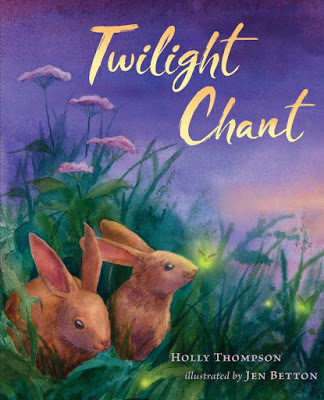
From the idea to publication, the process for this 2018 picture book took a little over four years.
A picture book is a team effort, and I’m so grateful to all of the individuals involved in turning my twilight poem into a picture book, most especially my agent Jamie Weiss Chilton, editor Anne Hoppe and the talented illustrator Jen Betton. We all hope you enjoy Twilight Chant and many beautiful twilights.
*******See all four posts in this seriesWriting a Picture Book 1: A Twilight IdeaWriting a Picture Book 2: Twilight RevisionsWriting a Picture Book 3: Submission to OfferWriting a Picture Book 4: Contract to Illustrator to Launch
Part 4 of 4: Contract to Illustrator to Launch
Twilight Chant, by Holly Thompson, illustrated by Jen Betton
In August 2014, the draft contract for my picture book Twilight Chant was drawn up, and later that fall I signed the final contract. In November, announcements appeared in Publishers Marketplaceand Publishers Lunch:
Holly Thompson's TWILIGHT CHANT, a lyrical evocation of the transition between day and night and an exploration of the animals who thrive during this special time, to Anne Hoppe at Clarion, by Jamie Weiss Chilton at Andrea Brown Literary Agency (World).

Over the next year, and throughout the following year, the editorial team considered various illustrators for Twilight Chant. As the author, I was not privy to most of these developments, until April 2016, when I received news from Anne Hoppe that illustrator Jen Betton had been selected and was already at work with HMHKids art director Christine Kettner. Anne Hoppe praised Jen’s sensitivity in portraying animals with the following words:
“She creates a lovely blend of realism and personification, giving her animals a sense of sentience and subtle personality without making them anthropomorphic,” and also Jen's “ability to create lowlight and nighttime scenes that are neither dark nor murky.”
—Anne Hoppe 4/5/16
In October 2016, I received from Anne Hoppe an update email on the illustration process with some of Jen's Twilight Chant sketches attached. Anne’s comments included the confirmed order of the animals and requests for slight revisions to the Author’s Note to keep the note in-tone and age-appropriate without overloading with information. And she shared the exciting news that the book would be published in spring 2018.
In November 2016 by email I received a sample of Jen Betton’s gorgeous finished art for “Fireflies,” and in January 2017, I received more of Jen’s stunning artwork for Twilight Chant. At the writing end, there was little to do other than fiddle with a dedication and the back jacket flap copy. At the publisher’s end, front flap copy and descriptive copy were being crafted. In May 2017, I received an email with Jen’s beautiful wrap-around cover art.

During the illustration process for a picture book, illustrators and writers usually have no contact with each other, but after the finished art was complete, in August 2017 I was so pleased to receive an email from Jen Betton reaching out about coordinating to create a Teacher’s Guide. Since I was visiting Massachusetts that month and she was living in the Boston area then, we were able to meet face to face, share our Teacher’s Guide and school visit ideas and discuss blog posts about process.
In late 2017, the first review came out, from Kirkus with these sweet words:
“A lovely, lyrical visual and verbal exploration of the wonders of twilight.”
And more recently from Booklist these words, so gratifying:
“A lovely science picture book.”
Jen and I have continued to collaborate on the Teacher’s Guide with Marcie Colleen, and we have confirmed our book launch at Porter Square Books in Cambridge, Massachusetts, on Friday evening March 23—nicely timed for this particular book, so soon after the vernal equinox, leading to longer days, warmer weather and opportunities for observing the three stages of twilight and the wildlife that thrives at that time of day.

From the idea to publication, the process for this 2018 picture book took a little over four years.
A picture book is a team effort, and I’m so grateful to all of the individuals involved in turning my twilight poem into a picture book, most especially my agent Jamie Weiss Chilton, editor Anne Hoppe and the talented illustrator Jen Betton. We all hope you enjoy Twilight Chant and many beautiful twilights.
*******See all four posts in this seriesWriting a Picture Book 1: A Twilight IdeaWriting a Picture Book 2: Twilight RevisionsWriting a Picture Book 3: Submission to OfferWriting a Picture Book 4: Contract to Illustrator to Launch
Published on February 23, 2018 05:00
February 22, 2018
Writing a Picture Book 3: Submission to Offer
A Twilight Chant Process Post
Part 3 of 4: Submission to Offer
Twilight Chant, by Holly Thompson, illustrated by Jen Betton
Soon after I sent the picture book manuscript off to my literary agent, Jamie Weiss Chilton (Andrea Brown Literary Agency), she wrote back with her thoughts.
She encouraged me to consider carefully the narrative arc created through the ordering of the animals. We emailed back and forth and discussed which animals to include and which to cut and why—where in N. America would all of these animals co-exist? All in one bio-zone or across bio-zones?
Also, some animals seemed to alter the tone and focus of the story. Some had a soothing effect, while others were a bit menacing and incongruous in a text that read like a chant, lullaby or soothing bedtime story. Jamie asked great questions that helped me refine my ideas. I worked on more drafts, until we agreed upon a final.
Before submitting to editors, my agent suggested I make a voice recording of myself reading the poem so that she and editors could listen to the way I heard the poem. I immediately made a recording. But of course, recording yourself reading a poem or story sends you right back to the manuscript to make improvements.
After more fiddly revisions, at the end of May 2014, I sent my agent the revised manuscript, which included 26 stanzas in 13 pairs for a total of 272 words.
Then in early June, my agent sent the manuscript and the voice recording out on submission to editors.
While a manuscript is out on submission, I move on to other projects, or at least I try to, but of course I’m waiting to hear news.

Soon, that June of 2014, we had a wonderful offer from an editor that I was eager to work with at Clarion/Houghton Mifflin Harcourt Books for Young Readers (@HMHKids)—Anne Hoppe.
The following month, I received my first email from Anne, now my editor, with these thrilling words:
“The text is so carefully rendered—lyrical and original, and amazingly evocative of this special time of day. I hadn't encountered the term "crepuscular" before and learning about these special animals is a bonus to beautiful text. I feel that you have created a truly fresh bedtime book—one that by its gentle refrain and sense of the day fading into night creates a calm and peaceful mood, one that might help lull a listener toward sleep without being yet another take on going to bed. Like crepuscular, though, this is just another bonus to what is overall a lovely, lovely text that I am certain will inspire gorgeous art.” –Anne Hoppe 7/19/2014
*******
See all four posts in this series
Writing a Picture Book 1: A Twilight Idea
Writing a Picture Book 2: Twilight Revisions
Writing a Picture Book 3: Submission to Offer
Writing a Picture Book 4: Contract to Illustrator to Launch
Part 3 of 4: Submission to Offer
Twilight Chant, by Holly Thompson, illustrated by Jen Betton
Soon after I sent the picture book manuscript off to my literary agent, Jamie Weiss Chilton (Andrea Brown Literary Agency), she wrote back with her thoughts.
She encouraged me to consider carefully the narrative arc created through the ordering of the animals. We emailed back and forth and discussed which animals to include and which to cut and why—where in N. America would all of these animals co-exist? All in one bio-zone or across bio-zones?

Also, some animals seemed to alter the tone and focus of the story. Some had a soothing effect, while others were a bit menacing and incongruous in a text that read like a chant, lullaby or soothing bedtime story. Jamie asked great questions that helped me refine my ideas. I worked on more drafts, until we agreed upon a final.
Before submitting to editors, my agent suggested I make a voice recording of myself reading the poem so that she and editors could listen to the way I heard the poem. I immediately made a recording. But of course, recording yourself reading a poem or story sends you right back to the manuscript to make improvements.
After more fiddly revisions, at the end of May 2014, I sent my agent the revised manuscript, which included 26 stanzas in 13 pairs for a total of 272 words.
Then in early June, my agent sent the manuscript and the voice recording out on submission to editors.
While a manuscript is out on submission, I move on to other projects, or at least I try to, but of course I’m waiting to hear news.

Soon, that June of 2014, we had a wonderful offer from an editor that I was eager to work with at Clarion/Houghton Mifflin Harcourt Books for Young Readers (@HMHKids)—Anne Hoppe.
The following month, I received my first email from Anne, now my editor, with these thrilling words:
“The text is so carefully rendered—lyrical and original, and amazingly evocative of this special time of day. I hadn't encountered the term "crepuscular" before and learning about these special animals is a bonus to beautiful text. I feel that you have created a truly fresh bedtime book—one that by its gentle refrain and sense of the day fading into night creates a calm and peaceful mood, one that might help lull a listener toward sleep without being yet another take on going to bed. Like crepuscular, though, this is just another bonus to what is overall a lovely, lovely text that I am certain will inspire gorgeous art.” –Anne Hoppe 7/19/2014
*******
See all four posts in this series
Writing a Picture Book 1: A Twilight Idea
Writing a Picture Book 2: Twilight Revisions
Writing a Picture Book 3: Submission to Offer
Writing a Picture Book 4: Contract to Illustrator to Launch
Published on February 22, 2018 05:00
February 21, 2018
February 20, 2018
January 4, 2018
Tomo Anthology Update
Happy 2018!
Six years ago, in 2012, the Tomo: Friendship Through Fiction anthology was going to press. In a period of just ten months from the March 11, 2011, Great East Japan Earthquake and Tsunami, I had proposed the anthology, Stone Bridge Press had agreed to publish, and I'd selected, compiled and edited the 36 stories, plus conducted interviews with most of the author illustrator and translator contributors. The aim of the Tomo anthology was to raise awareness outside of Japan about the need for longterm support for coastal communities in the Tohoku region by sharing Japan-related fiction for teens, and, most critically, to provide funding to NPOs serving teens in the hardest hit communities of Tohoku.
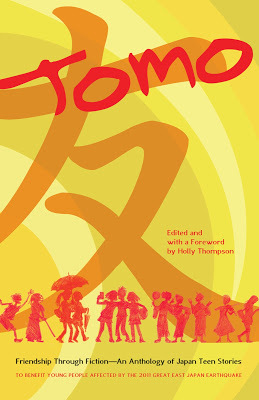
Until 2017, Tomo proceeds went to the NPO Hope for Tomorrow Japan, which in addition to providing educational expenses (including university entrance exam fees, travel costs to exam centers, etc.) also provided mentoring, tutoring, and foreign language support to high school students in hard-hit areas of Tohoku. But in 2017, the NPO Hope for Tomorrow closed its doors after its planned five years of supporting teen education in Tohoku.
Now, although Tomo is no longer available in print, the Kindle edition is still available for purchase, and sales of Tomo still generate small sums of money for donations. Recently, additional funds were generated through adoption of Tomo material via the international Copyright Clearance Center for educational purposes.
So in 2017, I set out to find other NPOs to receive Tomo donations.
In late October, I drove north to Tohoku to visit the cities of Ishinomaki and Kesennuma in coastal Miyagi Prefecture, and Rikuzentakata in Iwate Prefecture. My aim was to revisit some of the areas severely ravaged by the March 11, 2011 Great Eastern Japan Earthquake and Tsunami. Such a trip is haunting, moving and painful, yet at the same time, energizing and inspiring. Signs of loss and devastation are evident in the violently scarred coast, in elevation markers for inundation levels even high in the hills, in remaining ruined structures and temporary housing, and in the massive seawalls and ambitious city reconstruction projects underway. The reach of the monstrous tsunami left cruel before-and-after, have-and-have-not markers throughout communities up and down the jagged coast. People are left coping with unspeakable trauma. Yet there is evidence of brave determination among so many citizens to nurture their communities into wellness and vibrancy, to take actions toward healing, remembering, learning and growing.
 Torï at Hiyoriyama Park in Ishinomaki
Torï at Hiyoriyama Park in Ishinomaki
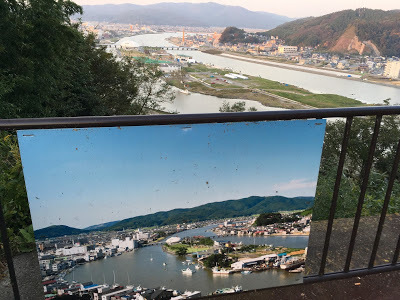 From Ishinomaki's Hiyoriyama Park: a fence shows the view before 3/11 photo, and the current sceneIn Ishinomaki downtown streets, where in the spring of 2011 (see my Peace Boat blog posts) I'd shoveled tsunami muck out of surviving shops, businesses and homes, a lively downtown is now evidenced with new and revived stores, restaurants, and community initiatives. Practically across the street from a soba shop I'd helped muck out in 2011, is the new Penguins Art Kōbō, a studio where everyone is welcome to create, and there I joined a morning clay workshop.
From Ishinomaki's Hiyoriyama Park: a fence shows the view before 3/11 photo, and the current sceneIn Ishinomaki downtown streets, where in the spring of 2011 (see my Peace Boat blog posts) I'd shoveled tsunami muck out of surviving shops, businesses and homes, a lively downtown is now evidenced with new and revived stores, restaurants, and community initiatives. Practically across the street from a soba shop I'd helped muck out in 2011, is the new Penguins Art Kōbō, a studio where everyone is welcome to create, and there I joined a morning clay workshop.
 Penguins Art clay workshopIn the Ibarazu neighborhood where I'd helped gather tons of rotting fish that had been strewn with wreckage far inland from the destroyed fish market, new parks and houses had sprouted. The pristeen new Ishinomaki fish market (Ishinomaki uoichiba) nearby is now the largest in Japan and visitors are welcome. I ate an incredible sushi lunch at Fukizushi (富喜寿司) near Ishinomaki Station. I made new, dear friends in Ishinomaki, and I dined and stayed at the NPO-run Long Beach House not far from Ibarazu.
Penguins Art clay workshopIn the Ibarazu neighborhood where I'd helped gather tons of rotting fish that had been strewn with wreckage far inland from the destroyed fish market, new parks and houses had sprouted. The pristeen new Ishinomaki fish market (Ishinomaki uoichiba) nearby is now the largest in Japan and visitors are welcome. I ate an incredible sushi lunch at Fukizushi (富喜寿司) near Ishinomaki Station. I made new, dear friends in Ishinomaki, and I dined and stayed at the NPO-run Long Beach House not far from Ibarazu.
In Oginohama, where in 2011, I'd helped clean the Inari shrine grounds and assist with myriad tasks for a late summer festival, a new café sits opposite the sea below the torī leading to the steep set of stairs up to the hilltop shrine.
In Rikuzentakata, I paid a visit to the Miracle Pine.
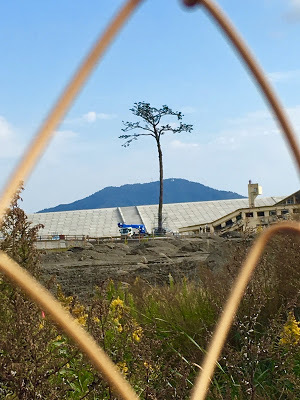 Miracle Pine in RikuzentakataI watched the constant, mind-numbing parade of construction vehicles essentially reshaping the land into a new elevated city. I also spent time in the children's section of Rikuzentakata's beautiful new library in the Abasse Shopping Center high up on raised ground.
Miracle Pine in RikuzentakataI watched the constant, mind-numbing parade of construction vehicles essentially reshaping the land into a new elevated city. I also spent time in the children's section of Rikuzentakata's beautiful new library in the Abasse Shopping Center high up on raised ground.
 Rikuzentakata library
Rikuzentakata library
 Rikuzentakata libraryAnd in Kesennuma I visited the Rias Ark Museum of Art for its contemporary art and local history exhibits, as well as the exhibits relating to the 2011 earthquake and tsunami and tsunami history in Tohoku.
Rikuzentakata libraryAnd in Kesennuma I visited the Rias Ark Museum of Art for its contemporary art and local history exhibits, as well as the exhibits relating to the 2011 earthquake and tsunami and tsunami history in Tohoku.
 Photos from the Rias Ark Museum of Art website: http://rias-ark.sakura.ne.jp/2/My Tohoku visit led to more questions, more explorations and more NPO discoveries.
Photos from the Rias Ark Museum of Art website: http://rias-ark.sakura.ne.jp/2/My Tohoku visit led to more questions, more explorations and more NPO discoveries.
And now, at the start of 2018, I'm proud to share with you two NPOs that I have selected to receive Tomo funds.
In December 2017, a donation of 100,000 JPY (about 900 USD) was made to the NPO Sokoage, based in Kesennuma City in Miyagi Prefecture.
 Sokoage website photo: http://sokoage.org/Sokoage (底上げ) meaning "raising up" engages high school students in community building and problem solving by encouraging students to take initiative to become thoughtful changemakers and by supporting their projects to create a vibrant new society. Projects have included the creation of a meeting and gathering space near the high school for students and Sokoage staff members; holding monthly community meal events with guest speakers; guiding students in getting to know their community, as well as creating materials to promote the region and record experiences of 3/11; providing volunteer academic support in temporary housing sites and elsewhere; encouraging students who have graduated from high school to stay involved in Kesennuma issues and events; holding supportive training camps for college students.
Sokoage website photo: http://sokoage.org/Sokoage (底上げ) meaning "raising up" engages high school students in community building and problem solving by encouraging students to take initiative to become thoughtful changemakers and by supporting their projects to create a vibrant new society. Projects have included the creation of a meeting and gathering space near the high school for students and Sokoage staff members; holding monthly community meal events with guest speakers; guiding students in getting to know their community, as well as creating materials to promote the region and record experiences of 3/11; providing volunteer academic support in temporary housing sites and elsewhere; encouraging students who have graduated from high school to stay involved in Kesennuma issues and events; holding supportive training camps for college students.
And in early January 2018, a donation of 30,000 JPY (about 270 USD) was made to the NPO Penguins Art Kōbō (ペンギンズアート工房), based in Ishinomaki, Miyagi Prefecture.
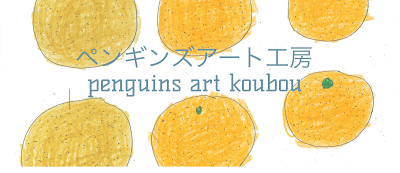 Penguins Art Kobo website: www.penginscafe.jp
Penguins Art Kobo website: www.penginscafe.jp
 Kazuko Miyakawa, Directory of Penguins Art KoboPenguins Art Kōbō is housed in an Ishinomaki downtown studio with a charming penguin logo on the shop shutter. Penguins Art aims to foster artistic expression in differently abled children, to create exhibition opportunities for them, and to enable group art experiences for all individuals in greater Ishinomaki. Established by former art teacher Kazuko Miyakawa, Penguins Art Kobo is a warm, supportive and welcoming oasis for everyone to explore creative expression.
Kazuko Miyakawa, Directory of Penguins Art KoboPenguins Art Kōbō is housed in an Ishinomaki downtown studio with a charming penguin logo on the shop shutter. Penguins Art aims to foster artistic expression in differently abled children, to create exhibition opportunities for them, and to enable group art experiences for all individuals in greater Ishinomaki. Established by former art teacher Kazuko Miyakawa, Penguins Art Kobo is a warm, supportive and welcoming oasis for everyone to explore creative expression.
I hope you'll visit the websites of these NPOs now receiving Tomo support.
Thank you to all of the Tomo contributors and friends, wherever you may be. May the Tomo anthology continue to create friendships through fiction as together we strive to support teens in Tohoku, Japan.
Six years ago, in 2012, the Tomo: Friendship Through Fiction anthology was going to press. In a period of just ten months from the March 11, 2011, Great East Japan Earthquake and Tsunami, I had proposed the anthology, Stone Bridge Press had agreed to publish, and I'd selected, compiled and edited the 36 stories, plus conducted interviews with most of the author illustrator and translator contributors. The aim of the Tomo anthology was to raise awareness outside of Japan about the need for longterm support for coastal communities in the Tohoku region by sharing Japan-related fiction for teens, and, most critically, to provide funding to NPOs serving teens in the hardest hit communities of Tohoku.

Until 2017, Tomo proceeds went to the NPO Hope for Tomorrow Japan, which in addition to providing educational expenses (including university entrance exam fees, travel costs to exam centers, etc.) also provided mentoring, tutoring, and foreign language support to high school students in hard-hit areas of Tohoku. But in 2017, the NPO Hope for Tomorrow closed its doors after its planned five years of supporting teen education in Tohoku.
Now, although Tomo is no longer available in print, the Kindle edition is still available for purchase, and sales of Tomo still generate small sums of money for donations. Recently, additional funds were generated through adoption of Tomo material via the international Copyright Clearance Center for educational purposes.
So in 2017, I set out to find other NPOs to receive Tomo donations.
In late October, I drove north to Tohoku to visit the cities of Ishinomaki and Kesennuma in coastal Miyagi Prefecture, and Rikuzentakata in Iwate Prefecture. My aim was to revisit some of the areas severely ravaged by the March 11, 2011 Great Eastern Japan Earthquake and Tsunami. Such a trip is haunting, moving and painful, yet at the same time, energizing and inspiring. Signs of loss and devastation are evident in the violently scarred coast, in elevation markers for inundation levels even high in the hills, in remaining ruined structures and temporary housing, and in the massive seawalls and ambitious city reconstruction projects underway. The reach of the monstrous tsunami left cruel before-and-after, have-and-have-not markers throughout communities up and down the jagged coast. People are left coping with unspeakable trauma. Yet there is evidence of brave determination among so many citizens to nurture their communities into wellness and vibrancy, to take actions toward healing, remembering, learning and growing.
 Torï at Hiyoriyama Park in Ishinomaki
Torï at Hiyoriyama Park in Ishinomaki
 From Ishinomaki's Hiyoriyama Park: a fence shows the view before 3/11 photo, and the current sceneIn Ishinomaki downtown streets, where in the spring of 2011 (see my Peace Boat blog posts) I'd shoveled tsunami muck out of surviving shops, businesses and homes, a lively downtown is now evidenced with new and revived stores, restaurants, and community initiatives. Practically across the street from a soba shop I'd helped muck out in 2011, is the new Penguins Art Kōbō, a studio where everyone is welcome to create, and there I joined a morning clay workshop.
From Ishinomaki's Hiyoriyama Park: a fence shows the view before 3/11 photo, and the current sceneIn Ishinomaki downtown streets, where in the spring of 2011 (see my Peace Boat blog posts) I'd shoveled tsunami muck out of surviving shops, businesses and homes, a lively downtown is now evidenced with new and revived stores, restaurants, and community initiatives. Practically across the street from a soba shop I'd helped muck out in 2011, is the new Penguins Art Kōbō, a studio where everyone is welcome to create, and there I joined a morning clay workshop. Penguins Art clay workshopIn the Ibarazu neighborhood where I'd helped gather tons of rotting fish that had been strewn with wreckage far inland from the destroyed fish market, new parks and houses had sprouted. The pristeen new Ishinomaki fish market (Ishinomaki uoichiba) nearby is now the largest in Japan and visitors are welcome. I ate an incredible sushi lunch at Fukizushi (富喜寿司) near Ishinomaki Station. I made new, dear friends in Ishinomaki, and I dined and stayed at the NPO-run Long Beach House not far from Ibarazu.
Penguins Art clay workshopIn the Ibarazu neighborhood where I'd helped gather tons of rotting fish that had been strewn with wreckage far inland from the destroyed fish market, new parks and houses had sprouted. The pristeen new Ishinomaki fish market (Ishinomaki uoichiba) nearby is now the largest in Japan and visitors are welcome. I ate an incredible sushi lunch at Fukizushi (富喜寿司) near Ishinomaki Station. I made new, dear friends in Ishinomaki, and I dined and stayed at the NPO-run Long Beach House not far from Ibarazu.In Oginohama, where in 2011, I'd helped clean the Inari shrine grounds and assist with myriad tasks for a late summer festival, a new café sits opposite the sea below the torī leading to the steep set of stairs up to the hilltop shrine.
In Rikuzentakata, I paid a visit to the Miracle Pine.
 Miracle Pine in RikuzentakataI watched the constant, mind-numbing parade of construction vehicles essentially reshaping the land into a new elevated city. I also spent time in the children's section of Rikuzentakata's beautiful new library in the Abasse Shopping Center high up on raised ground.
Miracle Pine in RikuzentakataI watched the constant, mind-numbing parade of construction vehicles essentially reshaping the land into a new elevated city. I also spent time in the children's section of Rikuzentakata's beautiful new library in the Abasse Shopping Center high up on raised ground. Rikuzentakata library
Rikuzentakata library
 Rikuzentakata libraryAnd in Kesennuma I visited the Rias Ark Museum of Art for its contemporary art and local history exhibits, as well as the exhibits relating to the 2011 earthquake and tsunami and tsunami history in Tohoku.
Rikuzentakata libraryAnd in Kesennuma I visited the Rias Ark Museum of Art for its contemporary art and local history exhibits, as well as the exhibits relating to the 2011 earthquake and tsunami and tsunami history in Tohoku. Photos from the Rias Ark Museum of Art website: http://rias-ark.sakura.ne.jp/2/My Tohoku visit led to more questions, more explorations and more NPO discoveries.
Photos from the Rias Ark Museum of Art website: http://rias-ark.sakura.ne.jp/2/My Tohoku visit led to more questions, more explorations and more NPO discoveries.And now, at the start of 2018, I'm proud to share with you two NPOs that I have selected to receive Tomo funds.
In December 2017, a donation of 100,000 JPY (about 900 USD) was made to the NPO Sokoage, based in Kesennuma City in Miyagi Prefecture.
 Sokoage website photo: http://sokoage.org/Sokoage (底上げ) meaning "raising up" engages high school students in community building and problem solving by encouraging students to take initiative to become thoughtful changemakers and by supporting their projects to create a vibrant new society. Projects have included the creation of a meeting and gathering space near the high school for students and Sokoage staff members; holding monthly community meal events with guest speakers; guiding students in getting to know their community, as well as creating materials to promote the region and record experiences of 3/11; providing volunteer academic support in temporary housing sites and elsewhere; encouraging students who have graduated from high school to stay involved in Kesennuma issues and events; holding supportive training camps for college students.
Sokoage website photo: http://sokoage.org/Sokoage (底上げ) meaning "raising up" engages high school students in community building and problem solving by encouraging students to take initiative to become thoughtful changemakers and by supporting their projects to create a vibrant new society. Projects have included the creation of a meeting and gathering space near the high school for students and Sokoage staff members; holding monthly community meal events with guest speakers; guiding students in getting to know their community, as well as creating materials to promote the region and record experiences of 3/11; providing volunteer academic support in temporary housing sites and elsewhere; encouraging students who have graduated from high school to stay involved in Kesennuma issues and events; holding supportive training camps for college students.And in early January 2018, a donation of 30,000 JPY (about 270 USD) was made to the NPO Penguins Art Kōbō (ペンギンズアート工房), based in Ishinomaki, Miyagi Prefecture.
 Penguins Art Kobo website: www.penginscafe.jp
Penguins Art Kobo website: www.penginscafe.jp
 Kazuko Miyakawa, Directory of Penguins Art KoboPenguins Art Kōbō is housed in an Ishinomaki downtown studio with a charming penguin logo on the shop shutter. Penguins Art aims to foster artistic expression in differently abled children, to create exhibition opportunities for them, and to enable group art experiences for all individuals in greater Ishinomaki. Established by former art teacher Kazuko Miyakawa, Penguins Art Kobo is a warm, supportive and welcoming oasis for everyone to explore creative expression.
Kazuko Miyakawa, Directory of Penguins Art KoboPenguins Art Kōbō is housed in an Ishinomaki downtown studio with a charming penguin logo on the shop shutter. Penguins Art aims to foster artistic expression in differently abled children, to create exhibition opportunities for them, and to enable group art experiences for all individuals in greater Ishinomaki. Established by former art teacher Kazuko Miyakawa, Penguins Art Kobo is a warm, supportive and welcoming oasis for everyone to explore creative expression.I hope you'll visit the websites of these NPOs now receiving Tomo support.
Thank you to all of the Tomo contributors and friends, wherever you may be. May the Tomo anthology continue to create friendships through fiction as together we strive to support teens in Tohoku, Japan.
Published on January 04, 2018 23:58



